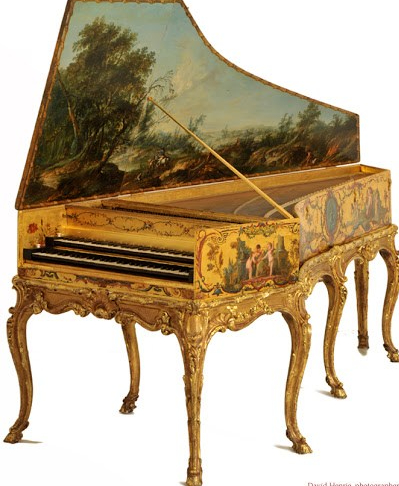François Couperin (1668 – 1733)
Louis Couperin had an interest in and a command of the contrapuntal keyboard technique and the conservative use of ornamentation and chord selection. Generally, only especially long note values received ornaments to sustain the sound. He favoured and manifested the use of major and minor tonalities. In his Sarabande, he notoriously began on the imitative third beat with an excellent voice leading throughout the imitation.
The repetition of phrases were an emphasis of his musical ideas. In general, it is rare to find the note values smaller than eight notes (insert eight notes).
Around 1655, the young Louis Couperin performed symphonic captured the attention of Chambonniéres. He sponsored the young Couperin (1626 – 1661), took him to Paris and presented him at the Court. He become the organists at church of Saint Gervais and Kings Chapel.
François Couperin was the nephew to Louis Couperin known as Le Grand (the Great). Chambonniéres and Louis Couperin firmly established the French Clavecin or harpsichord tradition, where both style and technique were peaked by the creation of François Couperin.
There were seven generations of the Couperin family that successfully filled the organ positions at the church of Saint Gervais in Paris, but Francois Couperin was the genius. He published four harpsichord collections in Paris, but his famous L’Art de Toucher le Clavecin (The Art of playing the Harpsichord) came to fruition in 1717. Instead of practicing the common practice in gathering pieces to suites, Couperin put his pieces into large groups called 27 ordres or orders. The first and the last piece were always in the same tonality. An ordre began with Allemande, Courante and Sarabande, but mostly contained descriptive titles or fanciful titles.
Couperin’s art often depicted what was seen in nature or the picturesque, instead of expressing his own inner sentiment. Couperin was very objective with his attempt was to express his technique and inspiration-melodic, contour, ornaments and harmonic colours and rhythms. He used arpeggiated harmony, and phrasings that were precisely balanced, and frequently used dotted rhythms making his style uniquely sensitive.
Each order itself, contained four to twenty-three pieces. In the first set it was reminiscent of the old tradition. He replaced the dances of the suites with dozens of evocative and descriptive miniatures namely Les Abeilles (Bees), Les Papillons (Butterflies), Les Moucherons (Flies), Les Rossignol en Amour (The Nightingale in love),and Les Bergeries (The Sheepfolds)
Sometimes, he mimicked objects, more or less animated by sound or movement: Le Reveille-matin (The Alarm Clock), Le Bavolet Flottant (The Floating Bonnet), Le Tic-toc-Choc (The Ticking Clock), Les Petits Moulins à vent (The Little Windmills). He also attempted this on more complicated subjects: Les Plaisirs de Saint-German-en-Laye (The pleasures of Saint-Germain), Le Carillon de Cythère (The Carillon of Cythera), Les Barricades mystérieuses (The Mysterious Barricades).
He even extended his horizons to character portrayals to give a good impression in which Couperin lived and worked: La Couperin (his wife); La Couperinette and la Crouilly (his daughter). There are other references to his colleagues: La Forqueray (Antoine Forqueray, viola da gamba player); La Garnier (Gabriel Garnier, organist at the Chapelle Royale); La Morinète (daughter of the composer Jean Baptise Morin).
The final collection of his ordre to this gallery of portrait is a group of what one might call ‘people of quality’; La Princesse Marie (Maria Leczinska, queen consort of France); La Mènetou (Mlle. De Mennetoud, daughter of the Duchesse de la Ferté). All these are what the French called them précieux and withal delightful.
François Couperin not only had a firm command of the harpsichord style, he also composed music, in which no one before had ever done. He possessed delicate and subtle harmonic freshness, melodic creation with firmness in line. He was colourful and never ceased to exhibit magnificent technique.
Jean- Phillip Rameau (1683 – 1764)
Rameau was an organist, Clavecinist, composer and theorist. Couperin and Rameau were both equally gifted. Jean-Phillip’s technique promised a firm musical substance but was a little less spontaneous than Couperin. His chief concern was to use the keyboard as a sustaining instrument, many of which sounded very effective on the piano. They set the highest artistic standard of French Clavecin composers. There were other composers who were also inspired by Rameau but very few equal to him.
‘Rameau is French rationalism in all its regularity and paradoxically, in all its freedom and even audacity of expression’
Jean Aubry
Rameau composed three volumes of harpsichord collections; the first volume, Pièces de Calvecin (1706) was published when he was twenty-three, and contained only ten pieces. Its style is reminiscent of Louis Marchand with whom Rameau admired. His early collections already exhibited the young Rameau’s personality and equilibrium to his later style.
On the second volume of Pièces de Calvecin (1724), confirmed Rameau’s personal style. Even though, there was Couperin’s arpeggiated harmony, it is mostly pure Rameau. His work reveals chromatic dissonance and unsual modulation. He audaciously composed pieces like Le Rappel des Oiseaux (The Recall of the Birds) and Tourbillons de poussière excites par de grands vents (Clouds of dust stirred up by gusts of wind). The music is often lyrically tender, with finesse and flexibility. It is lively with astonishing rhythmic invention.The agréments (ornaments) help to create the expression. Character pieces and works with provocative titles and description made up the sets.
The third volume Nouvelles Suites de Pièces de Clavecin (1726) remains the monumental landmark in harpsichord history. Here, he reinstates what he began in his second volume. In the piece called Le Trois Mains (The Three Hands), Rameau gives the illusion of three hands at the keyboard. Le Sauvages (The Savages) is a delightful sketch that Rameau later inserted into his opera-ballet work Les Indes Galantes (The Gallant Indies, 1735). In L’Enharmonique, he uses rapid modulations which was quite an unusual practice in the eighteen century.
Rameau is a true classic French School Clavecinist and the last of the great Clavecin composers.

Leave a comment